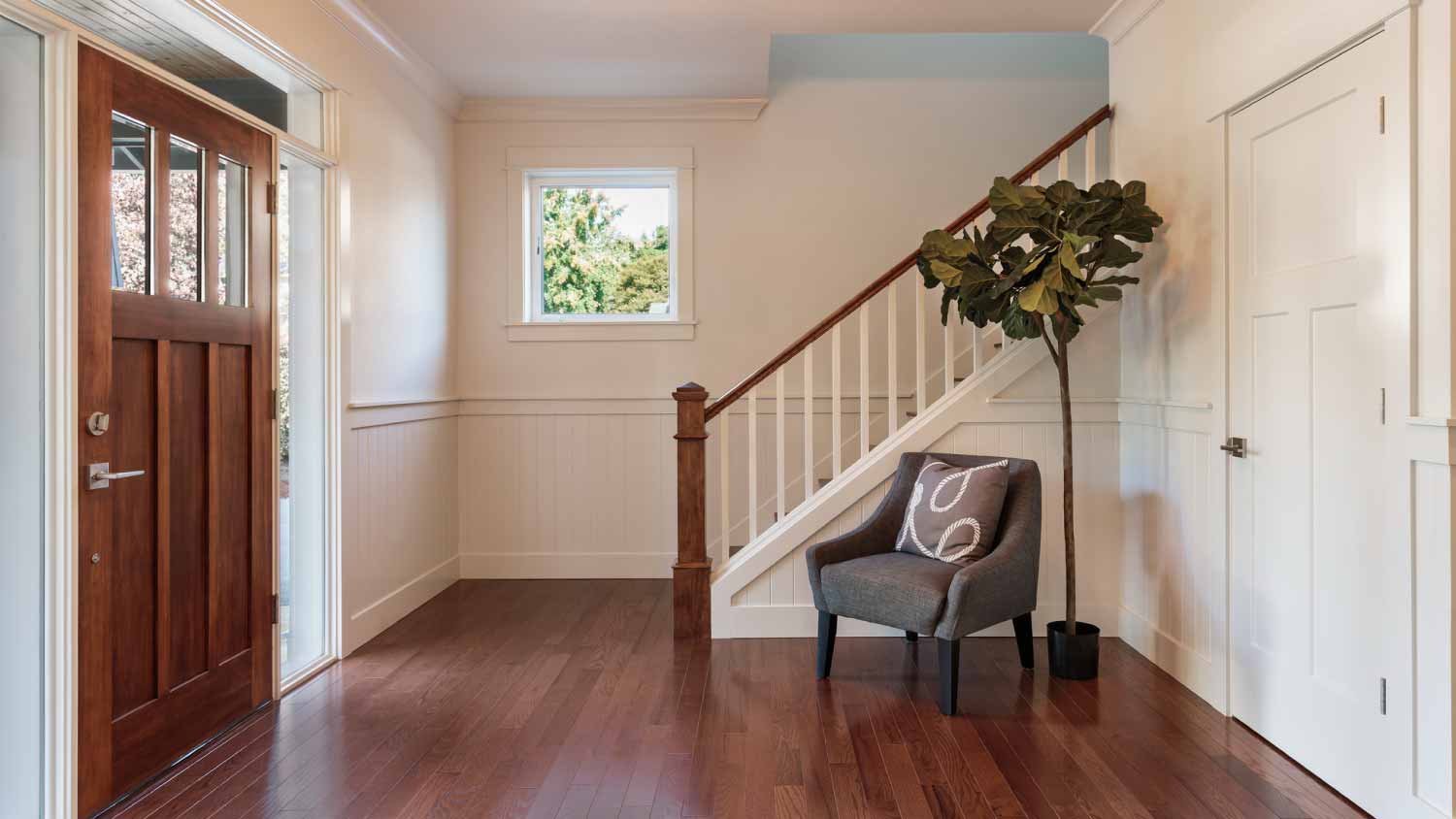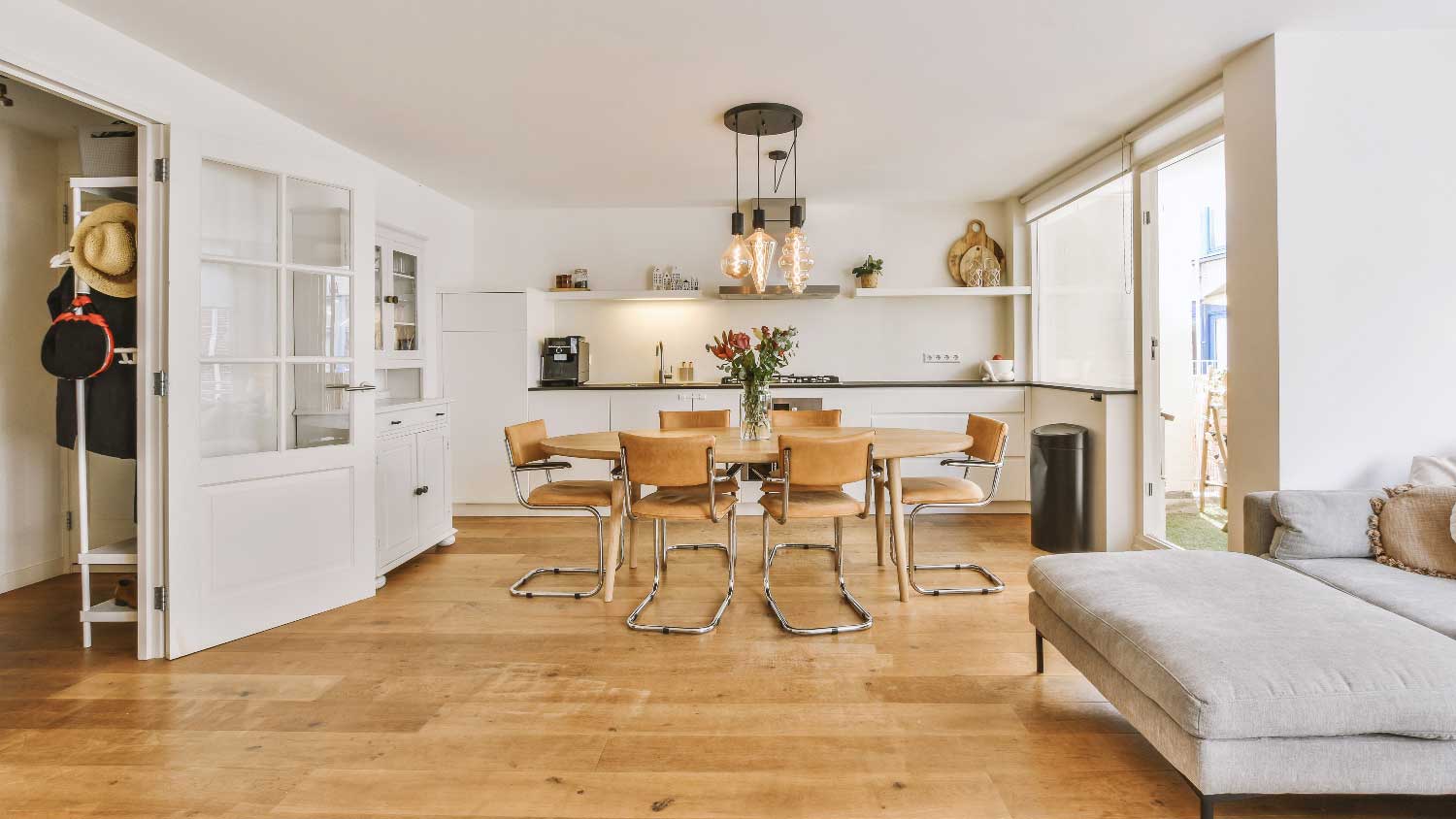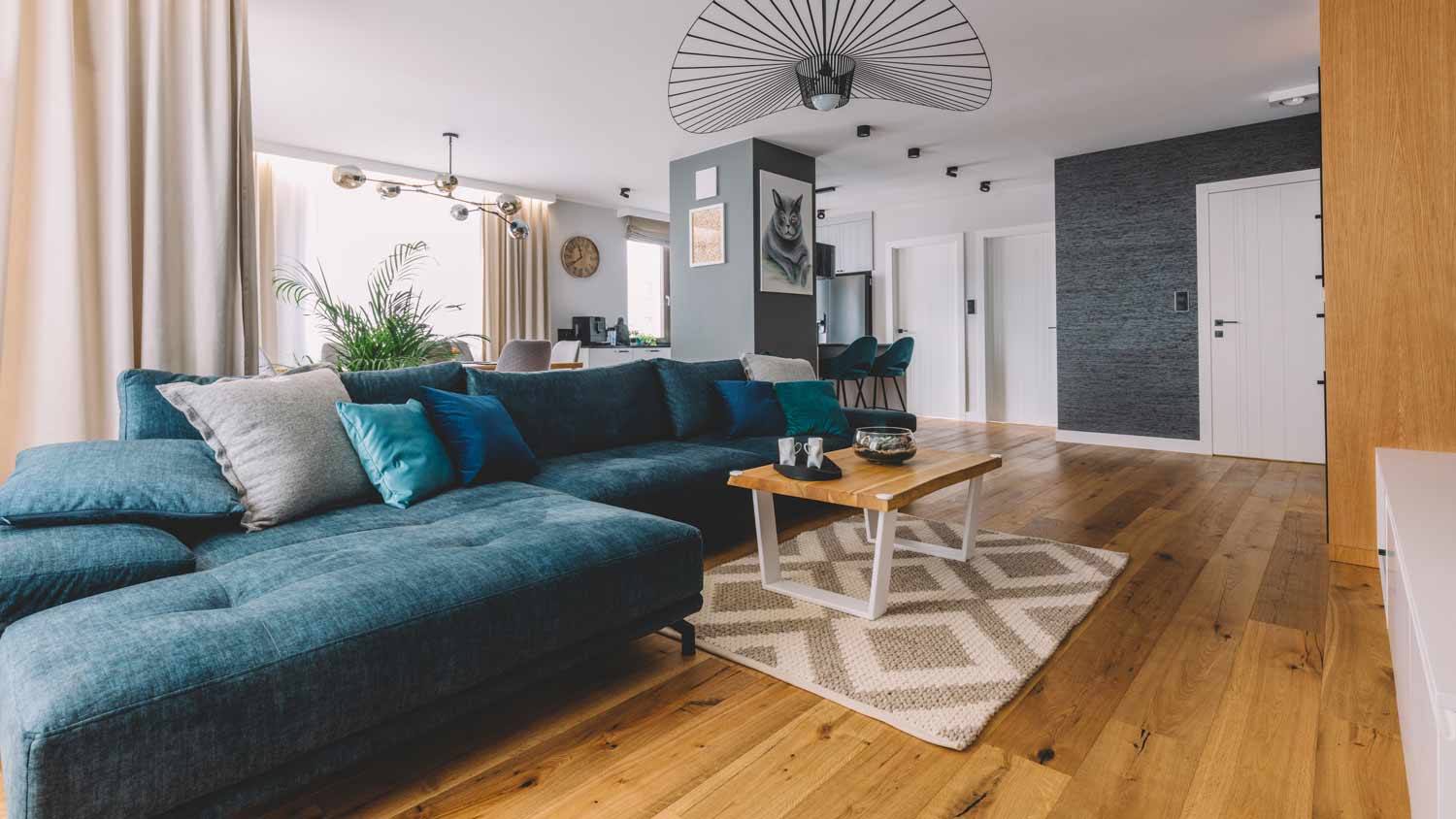How to Repair Laminate Flooring Water Damage: A Step-by-Step Guide
These simple steps can get your laminate floor back into action


- Miter saw
- Table saw
- Utility knife
- Safety glasses
- Hammer
- Laminate wood planks
- Flooring adhesive
- Sticky notes
- Super glue (optional)
A favorite of those with children and pets and a common feature in busy commercial spaces, laminate wood flooring is built to stand up to heavy use. While laminate fares particularly well against spills compared to other types of flooring, it’s no less susceptible to water damage from heavy leaks or moisture if it’s left to stand long enough. When this happens, it may be time to roll up your sleeves. This guide will show you how to repair laminate flooring water damage like a pro.
Prepping to Fix Laminate Flooring Water Damage
 Photos: nndanko / iStock / Getty Images Plus, Banepx / iStock / Getty Images Plus, Wicki58 / iStock / Getty Images Plus, Mukhina1 / iStock / Getty Images Plus, Michael Vi / iStock / Getty Images Plus, Petra Richli / iStock / Getty Images Plus, Westend61 / Getty Images
Photos: nndanko / iStock / Getty Images Plus, Banepx / iStock / Getty Images Plus, Wicki58 / iStock / Getty Images Plus, Mukhina1 / iStock / Getty Images Plus, Michael Vi / iStock / Getty Images Plus, Petra Richli / iStock / Getty Images Plus, Westend61 / Getty ImagesWhen enough water seeps into the laminate to damage the wood particle layer inside, you may notice signs of water damage throughout your floor. This includes buckling planks, bubbling or cracking in the surface of the laminate, and the appearance of mold. You cannot repair laminate flooring planks that have suffered this kind of damage, but you can replace them individually.
Before you begin, check to see if you have leftover materials from the original installation. Look in utility closets and other storage areas before purchasing new ones. If you do have to buy new flooring, make sure you purchase replacement planks that match your existing flooring. Keep in mind that coloring may slightly differ if your floors have worn over time or have seen regular exposure to UV light.
Stop the Source of Water Damage
 Photo: Nataliia / Adobe Stock
Photo: Nataliia / Adobe StockThe most important thing is to stop the source of the damage as soon as possible so it doesn’t warp more of your flooring. If you have a burst pipe pouring water onto your floor, turn off the water at the main line and call an emergency plumber near you. If the water damage is from a slow leak or a poor seal around a window, you may be able to DIY a fix but make sure to get the work done before repairing your floors.
Whatever the cause, if you don’t fix the problem, you’ll quickly find yourself back at square one.
It’s also important to determine the category of water damage. Dealing with clean water is one thing, but there are health risks if you’re dealing with gray water or black water. Call in a professional if there’s a health risk involved.
Clean Up Any Excess Moisture
 Photo: Creative Cat Studio / Adobe Stock
Photo: Creative Cat Studio / Adobe StockThe longer water sits on your laminate flooring, the more likely it is to do further damage to the planks and other materials. You want to prevent the water from seeping into more of your flooring and down to the subfloor, where it can do more expensive damage and develop mold.
Before you start your replacement, clean and dry the water-damaged flooring. To get rid of as much moisture as possible, run a blower fan for 24 to 48 hours. This is very often the first step in the water damage remediation process.
Inspect the Floor and Locate All Damaged Areas
 Photo: Milan / Adobe Stock
Photo: Milan / Adobe StockOnce you have neutralized the source of the water damage, inspect the whole floor, searching closely for all signs of damage. Look for discoloration, bubbling, cupping, crowning, signs of mold, cracks, and buckling or misshapen boards. Use sticky notes or cloth tape to mark the spots that require attention. If there are signs of more extensive mold damage affecting the whole floor, stop and contact a mold remediation specialist before proceeding.
After doing a visual survey, step on each potentially damaged board, feeling for any movement or changes to the shape. Mark any board showing these signs for replacement.
Remove Damaged Baseboards and Furniture
 Photo: diy13 / Adobe Stock
Photo: diy13 / Adobe StockRemove baseboards, thresholds, and molding by gently prying them away using a pry bar. Take care not to damage them during removal, as you'll need to reinstall them later. Consider replacing water-damaged baseboards and trim for a complete restoration.
Clear the area of any furniture and rugs so you can access the flooring.
Remove Damaged Planks Around the Edge of the Floor
 Photo: malkovkosta / Adobe Stock
Photo: malkovkosta / Adobe StockWear safety glasses as you begin removing damaged laminate planks. Unlike traditional flooring that’s fastened with adhesive or nails, laminate wood planks feature an interlocking system of tongues and grooves, so the planks are easy to detach by hand. Just tilt up the outer edge of the board and pull it away from the adjoining piece.
In some cases, you may need to remove undamaged planks to access and unlock those that are damaged. Set these aside for reinstallation at a later stage of the repair process.
Remove Damaged Planks in the Center of the Floor
 Photo: Dusan Ilic / E+ / Getty Images
Photo: Dusan Ilic / E+ / Getty ImagesIf you need to remove damaged planks in the center of your floor, it’s best to remove the surrounding planks until you reach the damage. However, you can also use a utility knife to cut at a 45-degree angle from each corner and then pry up the damaged plank.
Replace Damaged Planks
 Photo: Witthaya Prasongsin / Moment / Getty Images
Photo: Witthaya Prasongsin / Moment / Getty ImagesTo begin the floor replacement, start with planks in the center of the room. Cut the grooves off of your replacement plank, add some flooring adhesive to the underside, and then set it in place. Use some super glue on the edges to secure them to the adjoining pieces in lieu of interlocking grooves.
You can then work on edge pieces. Simply slide the new piece into place by tilting it and tucking the edge lock under the adjoining piece, pulling the two pieces together, and then laying the board flat. You can then slide the new piece into the correct position and use your rubber mallet to attach the tongues and grooves on the short edges of the pieces. Cut edge pieces to length with your miter saw and rip them to width, if necessary, with your table saw.
If you had to remove any baseboards, thresholds, or molding from the edges of the floor, line them back up in the order that you removed them. Take your new finishing nails and line them up with the existing holes, gently tacking each into place with a hammer.
Mistakes to Avoid When Repairing Laminate Floors
Repairing laminate floor water damage is a relatively straightforward process and is much easier than repairing a hardwood floor with water damage. Most DIYers with some experience will be able to tackle the project. You can ensure a more professional-looking floor and a smoother repair process by avoiding these common mistakes.
Failing to address the underlying water issue: No matter how carefully you replace your laminate flooring after water damage, the issue will only return and get worse if you don’t fix the underlying problem. If your damage wasn’t caused by a flood, make sure to have a professional plumber, window replacement specialist, or roof repair tech stop the leak permanently before you get started.
Not drying out the floor completely before starting: Laminate flooring will readily soak up and hold onto water, so you need to be diligent about drying the area before you get started. Run blower fans and dehumidifiers in the room for 48 to 72 hours before you assess the damage, or you may miss some planks that need replacement.
Not removing enough planks: Look carefully for damage to your flooring and make sure not to miss any planks that may have come in contact with water or moisture. Even minor exposure can worsen over time, so identifying and removing all damaged planks upfront is crucial for long-term success.
Failing to maintain an expansion gap: Laminate flooring naturally expands and contracts with changes in moisture. To allow for lateral expansion, leave at least a 1/4-inch gap between any walls and your flooring.
Not letting new floorboards acclimate: Getting your living space back to its original condition is probably your top priority when you find water damage, but if you have to buy new floorboards, leave them uninstalled in the room for 48 hours. This laminate flooring acclimation period will prevent boards from expanding and contracting after they’re installed and causing further damage.
How Much Does It Cost to Repair Laminate Flooring with Water Damage?
Homeowners can expect laminate floor repair costs to average $1,250 following water damage. Prices can sit as low as $150 for minor repairs to small areas, especially around the edge of the room, but they can also climb to $5,000 for extensive damage that requires a complete floor replacement.
Just keep in mind that extensive water damage may require repairs beyond your laminate flooring. Water damage remediation costs an average of $3,800, and most homeowners pay between $1,350 and $6,300.
DIY vs. Hiring a Pro
Laminate floor repair is relatively DIY-friendly. You can simply remove planks until you reach the damaged one, replace it, and then click the planks back in place. It’s a time-consuming project, but DIYers with experience should be able to tackle it without too much of an issue.
However, if you’ve never worked with laminate flooring before, hiring an expert is well worth the money for a quick fix and a professional look in your space. You should also hire a water damage restoration pro if you notice signs of mold under your floor or damage to your subfloor when you start removing planks. A laminate floor repair company near you can assess and repair deeper damage to avoid issues in the future.
Finally, if your damaged floor is just one area where water is affecting your living space, call a local water damage restoration company for complete repairs, including water extraction and mold remediation in addition to buildback.
Water damage can cause serious problems for flooring, such as warping, staining, and mold growth. If you suspect water damage is an issue, a flooring pro can diagnose the cause, make necessary repairs, and restore the integrity of your floor.
Frequently Asked Questions
You can replace individual planks of laminate flooring. It’s easiest to start at the edge of the room, removing the surrounding planks until you reach the damaged plank for replacement. After that, you can reinstall the undamaged planks, lock them into place, start with the planks surrounding the new plank, and move toward the edge of the room. Alternatively, you can cut out a center plank with a utility knife, remove the locking edges from a replacement plank, and stick it in place using flooring adhesive underneath and super glue on the edges.
To repair swollen laminate flooring, dry the area entirely using blower fans, dehumidifiers, and open windows in low-humidity conditions. Next, place heavy items on swollen boards to flatten them. This can work for minor floor movement, but you’ll need to replace planks that continue to give you an issue. To prevent additional swelling, ensure you address any moisture-related issues in the room.
Laminate flooring generally isn’t waterproof, but you can purchase specialized waterproof laminate planks. These planks are 100% impervious to water—but that doesn’t mean your floor is totally waterproof. Water can still seep below the seams and damage your subfloor if you don’t install them correctly. If you want a waterproof floor but can’t find waterproof laminate planks, you may want to try LVP (luxury vinyl planks) instead.
Mold can begin to grow in as little as 12 to 24 hours, especially if the room is warm, so drying the area is the first thing you should do after water damage. Because mold and mildew can cause a range of health issues, make sure you clean up any water damage as soon as possible and run blower fans and dehumidifiers for 24 to 72 hours to dry out the room and reduce the risk of mold growth.
Determining whether to repair or replace water-damaged laminate flooring depends on the severity of the water damage. If you just have a few damaged planks, repairing the section of affected flooring should be manageable, especially if you have some leftover floorboards from when the floor was installed. But if the entire floor was covered in standing water, you have subfloor damage, or you notice mold growth, it may make more sense to replace it. The cost to install new laminate flooring runs between $1,475 and $4,650.

.jpg?impolicy=leadImage)



















